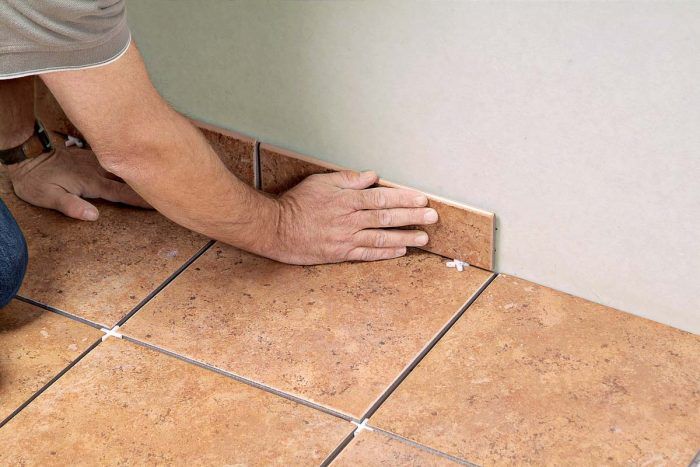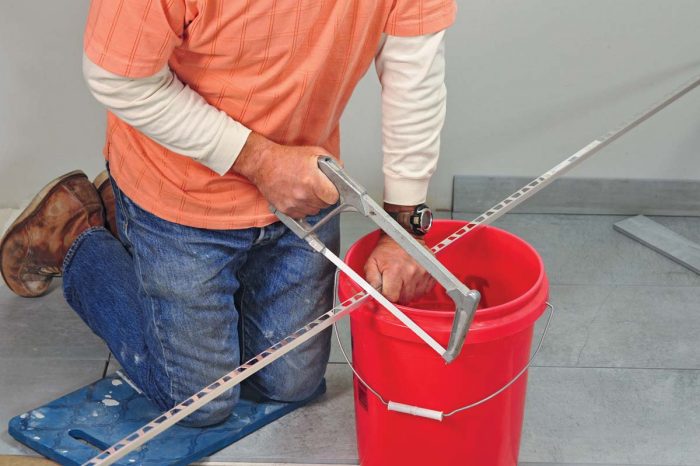Installing Floor Trim
Learn how to finish off a tile floor installation with tile base, edge trim, and transitional trim strips.

Setting Tile Base
A baseboard installed around the perimeter of a floor protects the walls from dents and scuffs due to brooms, vacuum cleaners, and other everyday wear 1. Tile base goes on after the floor is completely set but before it is grouted. If the base tiles are the same size as the field tiles, align the grout joints. Otherwise, find the center point of each wall and lay out the base tiles symmetrically, to yield the biggest cut pieces on either end. Backbutter each base piece and press it onto the wall surface 2, 3. Use a spacer or wedge to raise the base off the floor, to leave room for a caulk joint. Remember to fill this joint with caulk, not grout, as walls and floors can flex and move at different rates, causing grout to crack.
If you’re installing a wood base, you’ll want to nail it in place after the floor and grout are completely set. It’s best to stain or paint the wood before you set it in place to avoid drips or stains on your new tile floor. The nail holes will be easy to touch up.
| TRADE SECRET: If your chosen tile does not come with a surface bullnose that can be used as base trim, you can always cut a field tile to the desired height and set it with the cut edge down. |
Installing Edging
You’ll need to measure the thickness of your tile to help you select the appropriate-size edge trim. Another option is to take your tile to the store with you so that you can hold the trim piece in place to find the right size. Ideally, you want the tile and the trim piece to be as close as possible in size. Some companies offer a gauge tool that measures the thickness of the tile and is marked with the size of the matching trim you need.
Measure and cut your edge trim piece to the length you need 1. A new hacksaw blade will help to prevent skittering, but, in any case, take your time because the metal surface cannot be repaired. You can also use a tile saw to cut some softer metals or plastic edging. A tile rubbing stone can be used to smooth burrs 2.
Apply thinset and set the tile base. Slide the edge trim piece behind the tile while the thinset is workable 3. Use wedges or spacers to keep the grout line consistent between the tile and the trim. Wedges are also handy to adjust the trim against an irregular adjacent surface and to match the face of the tile 4.
After the thinset has cured, use a sponge or small scrub brush to clean the joints. Don’t use a razor knife as one slip could mar your beautiful trim and replacing it at this stage is very difficult. Grout as usual.
Trimming Floor Transitions
Often, a new tile floor butts up against an existing floor at a doorway or hall. If the tile is higher than the adjacent floor, you can sometimes use surface bullnose or quarter-round trim to finish off the edge. A more versatile solution is to install a metal trim strip. Schluter brand trim comes in different profiles and colors to suit transitions between tile and wood, carpet, and other kinds of flooring.
Installing this trim is much like setting tile. Start by laying down a strip of masking tape to protect the finished floor adjacent to the tile 1. Spread the thinset onto your substrate, in preparation for setting the last row of tile. Cut the trim strip to length and press its perforated edge firmly into the thinset 2. Align the strip with the edge of the finished flooring. Mark and cut the tiles to fit against the trim strip, leaving room for a caulk joint. Place these tiles into the thinset as you would normally set any floor tile 3. Before the thinset firms up, adjust the profile so that the grout joint is parallel and consistent with the floor tile. Let this dry for 24 hours and then grout the tile floor, leaving the joint between the metal trim strip and the tile open. Caulking this joint allows for movement between the two different floor materials.
 Excerpted from Tiling Complete, 2nd Edition by Robin Nicholas and Michael Schweit.
Excerpted from Tiling Complete, 2nd Edition by Robin Nicholas and Michael Schweit.
Available in the Taunton Store and at Amazon.com.

















